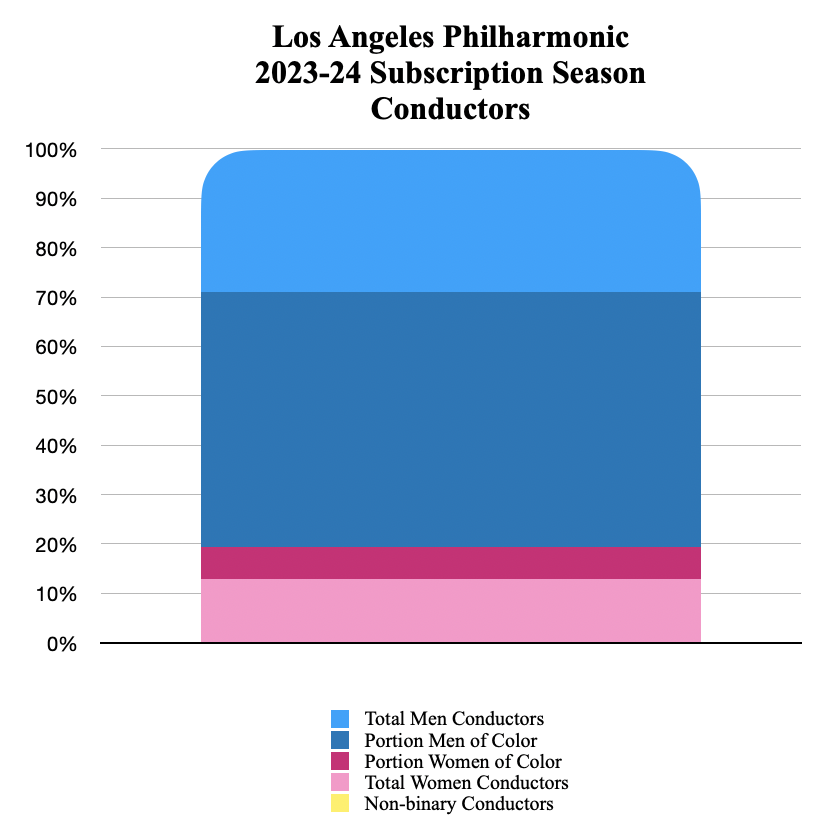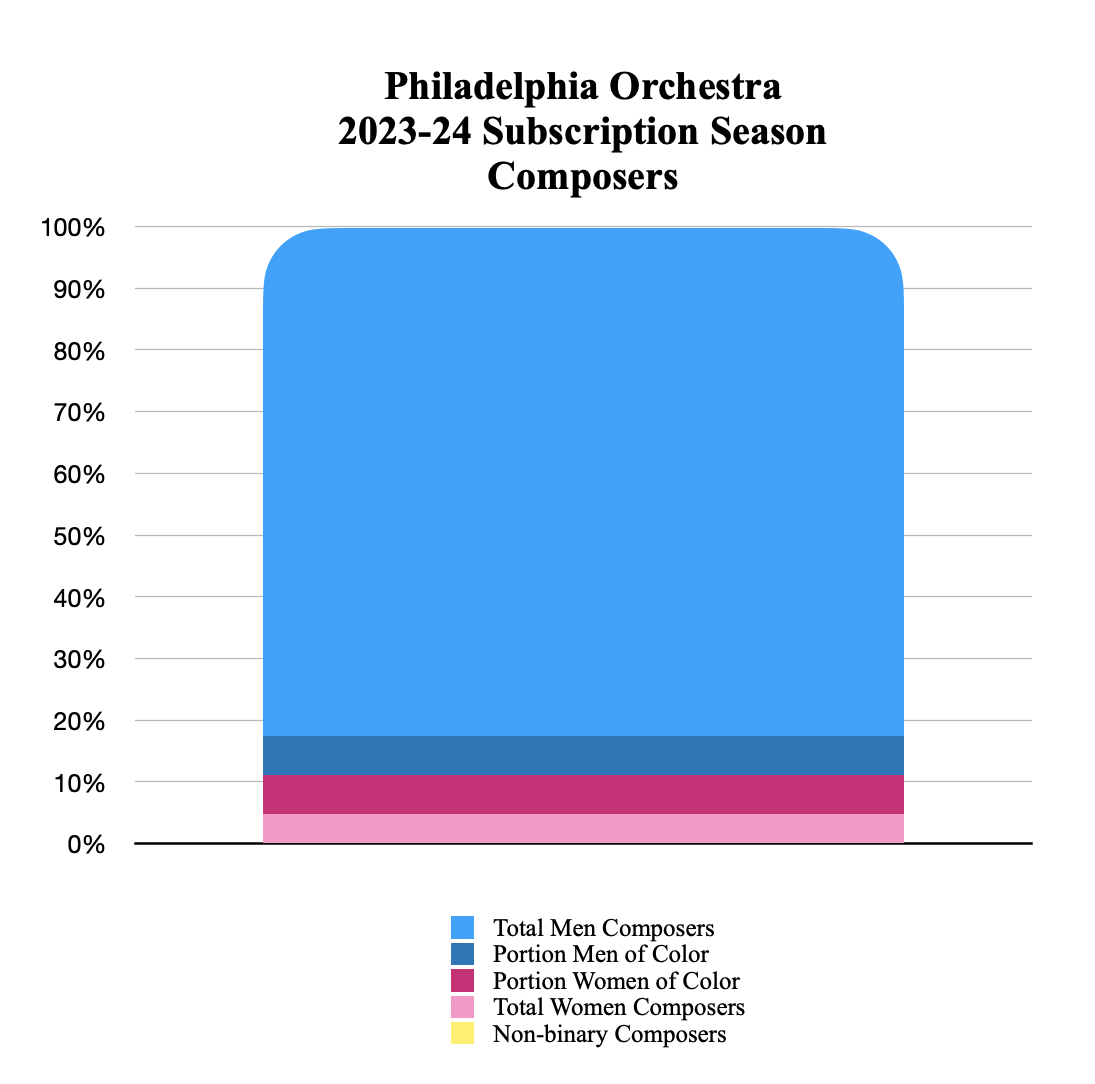I’m drawing statistics Based upon 2023-24 season announcements made by orchestras. please let me know of any errors I’ve made.
Chicago Symphony
2023-24 Subscription Week Stats
32 Weeks
I’m introducing a new category to my programming statistics for this year, one I’m calling “The Man Festival.” I am counting any week that is devoid of women in any head-lining role (as conductor, soloist, or composer of any piece on the program) as a “Man Festival.” I’ll count any weeks similarly devoid of men but with women in all of those positions as a “Woman Festival.” For 32 subscription weeks in Chicago, there are 18 whole Men Festivals, or 56% of the season. There are zero Women Festivals.
Many of these orchestras I will survey will have conductors who conduct multiple weeks. I will count any conductor conducting a subscription program as one. So, somebody conducting two weeks counts as two.
In the CSO’s case, no women conduct multiple weeks in 2023-24 but three men do. In the 2023-24 subscription, you will not see a woman soloist all the way until December 7, when Hilary Hahn appears. You will see one composition by a woman for the entire Fall 2023. You will not that second woman composer in this season until 2024. I was not able to identify any non-binary conductors, composers, or soloists in the program details. Please PM if I have misgendered anyone or made any other mistakes.
32 Total Conductors (9% women, 3% women of color*)
99 Total Compositions (6% women, 3% women of color)
26 Stand-Alone Soloists (19% women, 12% women of color)
11 Combination Soloists (55% women, 9% women of color)
3 Soloists Drawn from the Orchestra (33% women, 33% women of color)
32 second half/complete program works (0% women composers)
*The percentage of women of color listed here is of the whole, not the percentage of women.





Los Angeles Philharmonic
2023-24 Subscription Week Stats
30 weeks
This was actually a fun program book to go through. I think the number of men conductors of color is likely to be unmatched by any other orchestra I will survey. It is a majority of the programs here for the LAPhil. There were a lot of programs I’d be interested to hear myself with many commissioned works, and in my view—at least after spending so much time looking at Chicago’s program--a concerted effort to include some women composers and conductors. This has clearly been an institutional push and likely numerous people deserve credit. Compared to Chicago’s 18 Men Festivals, LA only has 13, or 43% of their season. Again, there are no Women Festivals. You'll see no major discrepancies in the representation over the different types of soloists here, to contrast Chicago. I’ll be interested to see how other orchestras stack up to LA.
31 Total Conductors (19% women, 6% women of color*)
76 Total Compositions (12% women, 7% women of color)
20 Stand-Alone Soloists (35% women, 10% women of color)
26 Combination Soloists (42% women, 15% women of color)
5 Soloists Drawn from the Orchestra (40% women, 20% women of color)
30 second half/complete program works (3.3% women composers; 3.3% women of color)
13 Men Festival Weeks (43% of the season)/0 Women Festival Weeks (0%)
*The percentage of women of color listed here is of the whole, not the percentage of women.





Philadelphia Orchestra
2023-24 Subscription Week Stats
24 weeks
I had been holding off on doing Philadelphia’s stats hoping they would name the vocal soloists (most of the combination ones) so I could count them, but they haven’t. At a sort-of quick glance (beyond the advertising photos), the season looked quite good relatively (like LA), so I went ahead and am just skipping the combo soloists for now. Philadelphia’s season is structured a bit differently than the other orchestras I’ve looked at so far. I’m just doing subscription classical weeks only with these stats, and the number of those weeks is less here that the previous two orchestras. I didn’t count several one-off programs with Yo-Yo Ma as soloist and other gala-type events which would likely drive the percentages of women composers/conductors/soloists down somewhat if I were to include them.
Of particular note are the priority given to two works being played on second halves: William Grant Still’s Fourth Symphony and Florence Price’s Fourth Symphony. I have not yet seen this attention to historical Black composers in combination with women composers for two programs of an orchestra’s season. Philadelphia programs two historical women composers (Price and Mahler) in addition to five living ones.
I was also happy to see a woman conductor I’ve not yet heard of, Polish conductor Anna Sułkowska-Migoń. Furthermore, the orchestra is featuring four of its principals as stand-alone soloists, including one in a commission of a work by a woman of color. All of these four soloists are either men of color, women, and/or women of color. This reflects the relative racial and gender diversity of their principal players.
Like the other orchestras I’ve looked at, I see no Women’s Music Festivals, and quite a number of men’s. The percentage of women composers is down quite a bit this season overall, where Philadelphia leads the other orchestras by a long shot. I’ll add Women Philharmonic Advocacy’s graph to show Philadelphia’s supremacy in this current season. Next season they will be quite a bit down at 11%; I don’t expect this number would go up if I were to add the Yo-Yo Ma/John Williams/Gala programming into the mix.
24 Total Conductors (21% women, 4% women of color*)
63 Total Compositions (11% women, 6% women of color)
19 Stand-Alone Soloists (32% women, 16% women of color)
4 Soloists Drawn from the Orchestra (50% women, 25% women of color)
24 second half/complete program works (4.1% women composers; 4.1% women of color)
10 Men Festival Weeks** (42% of the subscription season)/0 Women Festival Weeks (0%)
*The percentage of women of color listed here is of the whole, not the percentage of women.
**This number is currently advertised at 12, but I am assuming it will change once soloists are listed for Orff’s Carmina Burana and Puccini’s La Boheme.




